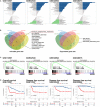An EMT-related gene signature for the prognosis of human bladder cancer
- PMID: 31657881
- PMCID: PMC6933372
- DOI: 10.1111/jcmm.14767
An EMT-related gene signature for the prognosis of human bladder cancer
Abstract
The transition from non-muscle-invasive bladder cancer (NMIBC) to muscle-invasive bladder cancer (MIBC) is detrimental to bladder cancer (BLCA) patients. Here, we aimed to study the underlying mechanism of the subtype transition. Gene set variation analysis (GSVA) revealed the epithelial-mesenchymal transition (EMT) signalling pathway with the most positive correlation in this transition. Then, we built a LASSO Cox regression model of an EMT-related gene signature in BLCA. The patients with high risk scores had significantly worse overall survival (OS) and disease-free survival (DFS) than those with low risk scores. The EMT-related gene signature also performed favourably in the accuracy of prognosis and in the subtype survival analysis. Univariate and multivariate Cox regression analyses demonstrated that the EMT-related gene signature, pathological N stage and age were independent prognostic factors for predicting survival in BLCA patients. Furthermore, the predictive nomogram model was able to effectively predict the outcome of BLCA patients by appropriately stratifying the risk score. In conclusion, we developed a novel EMT-related gene signature that has tumour-promoting effects, acts as a negative independent prognostic factor and might facilitate personalized counselling and treatment in BLCA.
Keywords: Cox; EMT; GEO; LASSO; TCGA; bladder cancer; signature.
© 2019 The Authors. Journal of Cellular and Molecular Medicine published by John Wiley & Sons Ltd and Foundation for Cellular and Molecular Medicine.
Conflict of interest statement
The authors declare that they have no competing interests.
Figures






References
-
- Bray F, Ferlay J, Soerjomataram I, Siegel RL, Torre LA, Jemal A. Global cancer statistics 2018: GLOBOCAN estimates of incidence and mortality worldwide for 36 cancers in 185 countries. CA Cancer J Clin. 2018;68(6):394‐424. - PubMed
-
- Glaser AP, Fantini D, Shilatifard A, Schaeffer EM, Meeks JJ. The evolving genomic landscape of urothelial carcinoma. Nat Rev Urol. 2017;14(4):215‐229. - PubMed
-
- Abdollah F, Gandaglia G, Thuret R, et al. Incidence, survival and mortality rates of stage‐specific bladder cancer in United States: a trend analysis. Cancer Epidemiol. 2013;37(3):219‐225. - PubMed
-
- Prout GR Jr, Barton BA, Griffin PP, Friedell GH. Treated history of noninvasive grade 1 transitional cell carcinoma. The National Bladder Cancer Group. J Urol. 1992;148(5):1413‐1419. - PubMed
-
- Knowles MA, Hurst CD. Molecular biology of bladder cancer: new insights into pathogenesis and clinical diversity. Nat Rev Cancer. 2015;15(1):25‐41. - PubMed
Publication types
MeSH terms
Substances
LinkOut - more resources
Full Text Sources
Medical

